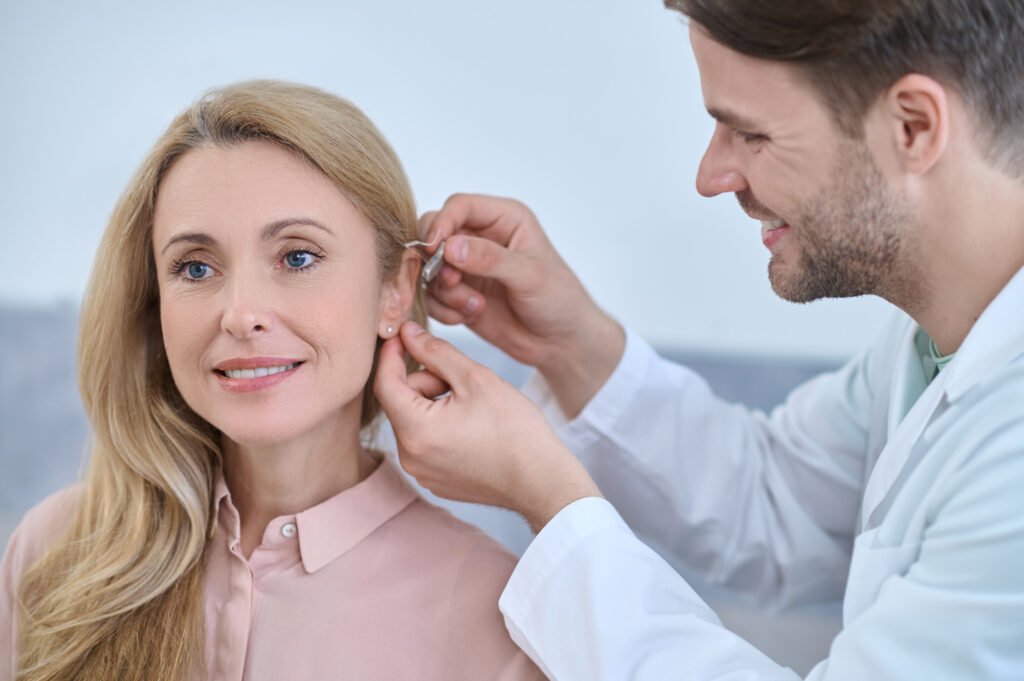
Age-related hearing loss
As we get older, our sense of hearing naturally declines. Some people develop age-related hearing loss – called presbycusis or presbyacusis – earlier than others. It is the result of the inevitable loss or damage to some of the tiny hair cells in the inner ear, which enable our hearing, over the course of our lifetimes. In this sense, many of us will experience a progressive hearing loss sooner or later.
Presbycusis develops gradually: Statistically, the quality of our hearing starts declining in our 40s. Typically by our 60s and 70s hearing loss reaches a degree when it is noticeable and recognizable as such. Above the age of 80, every second adult is living with hearing loss.
Signs of hearing loss
Presbycusis develops slowly, so many people do not immediately notice the decline in their ability to hear.
Instead, certain daily sounds slowly start disappearing, beginning with high-frequency or high-pitch sounds (such as children’s voices or birds chirping).
You may ask yourself: When did I last hear the birds singing, the humming of the refrigerator, the beep from the microwave oven or the sound of running water? You may feel forced to turn up the TV, have difficulty understanding conversations on the telephone, or miss the doorbell ringing. If you miss these sounds, it could be a sign of the onset of age-related hearing loss.
Another common symptom of age-related hearing impairment is difficulty hearing in situations with background noise such as at parties, social gatherings, meetings, conventions, and in restaurants.
If you experience some of these symptoms, the best advice is to have a hearing test to check your hearing. You should then contact your family doctor (GP) or a hearing care professional.
Noise
We are surrounded by noise in nearly all areas of modern life: At work, in traffic, and when listening to music or going to night clubs or concerts. Our ears are delicate and complex structures that are easily damaged. The more you listen to noise or loud sounds, the more likely it is to have your hearing damage.
How loud is “too loud”?
A continuous noise level of 85 dB will result in hearing damage and either cause permanent or temporary hearing loss. This is the sound level of heavy road traffic. Compressed air hammers have a sound level of about 100 dB and rock concerts almost always reach 110-120 dB – the same sound intensity can easily be produced in headsets when you listen to your stereo.
Diseases
Hearing loss may be the result of certain infectious or chronic diseases. Among the most common are:
• Middle ear inflammations (otitis media): Otitis media is generally not serious and does not normally cause permanent hearing problems if treated properly. Most often, it can be cured at home by means of medication. If a child contracts otitis media often or it is not treated, it may cause permanent damage to your child’s hearing.
• Otosclerosis: Abnormal bone growth in the middle ear causes the stapes (“stirrup” bone) to fuse with the surrounding bone, eventually becoming fixed so it cannot move. This means that the transmission of sound into the inner ear is reduced. In most cases, a surgical operation will restore hearing.
• Diabetes: Hearing impairment has been shown to be twice as common in adults with diabetes. Both diabetes type 1 and type 2 increase the risk of hearing loss. Why this is the case, is not yet fully understood by scientists. One theory is that that prolonged high blood glucose levels affects the supply of blood or oxygen to the tiny nerves and blood vessels of the inner ear. Over time, the nerves and blood vessels become damaged, and this affects the person’s ability to hear.
Otosclerosis
Abnormal bone growth in the middle ear causes the stapes (“stirrup” bone) to fuse with the surrounding bone, eventually becoming fixed so it cannot move. This means that the transmission of sound into the inner ear is reduced. In most cases, a surgical operation will restore hearing.
Diabetes
Hearing impairment has been shown to be twice as common in adults with diabetes. Both diabetes type 1 and type 2 increase the risk of hearing loss. Why this is the case, is not yet fully understood by scientists. One theory is that that prolonged high blood glucose levels affects the supply of blood or oxygen to the tiny nerves and blood vessels of the inner ear. Over time, the nerves and blood vessels become damaged, and this affects the person’s ability to hear.

Types of hearing loss
Sensorineural hearing loss (SNHL)
SNHL results from damage to the tiny hair cells in the inner ear, a part called the cochlea. SNHL is an inevitable consequence of ageing, as our nerve cells slowly grow old and break. In this case, SNHL typically develops gradually, so that we often do not notice that our hearing has worsened. SNHL is closely connected to the ageing process and is hence a central cause for age-related hearing loss.
But the hair cells can also be damaged by excessive noise exposure – for example from one’s work environment or loud music. If you have a sensorineural hearing loss in both ears (bilateral sensorineural hearing loss) and there is a great difference in hearing between the ears, it is called an asymmetric sensorineural hearing loss.
Conductive hearing loss
A conductive hearing loss occurs when the hearing hair cells are intact, but the ear’s ability to conduct sound from the external and middle ear to the hair cells in the cochlea is reduced, so that the sound never reaches the hair cells to begin with.
One of the most common causes of conductive hearing loss is a blockage in the external ear canal, usually caused by excessive earwax. But it can also be caused by the malformation or malfunction of parts of the ear, or damage to the outer ear or middle ear: For example, infections of the ear canal, a perforated or ruptured eardrum, cysts and tumours, or foreign objects in the ear canal. All of them impede the ear’s ability to transmit sound through the hearing canal.
Unilateral or bilateral hearing loss
All types of hearing loss can affect just one ear (unilateral) or both (bilateral). If a unilateral hearing loss is severe or profound, it is often called single-sided deafness (SSD). People with unilateral hearing loss often have problems localising sound (identifying where the sounds come from) and have problems understanding speech in noisy surroundings.
Sudden hearing loss
Sudden hearing loss is the loss of more than 30db in three contiguous frequencies that occurs over a period of less than three days. Sudden hearing loss can affect one ear (unilateral hearing loss) or both ears (bilateral hearing loss), and sometimes drop in as little as a few hours.
It can have many causes:
- A build-up of earwax, clogging the ear canal and hence your ear’s ability to transmit sound.
- Head trauma after an injury, affecting the hair cells.
- Vascular disorders, which affect the blood flow to the ear.
- A pierced eardrum.
If you suspect that you might have a sudden hearing loss, we recommend that you get your hearing checked by a professional. It is possible to recover from sudden hearing loss – spontaneous recovery occurs in many cases, usually within two weeks.


